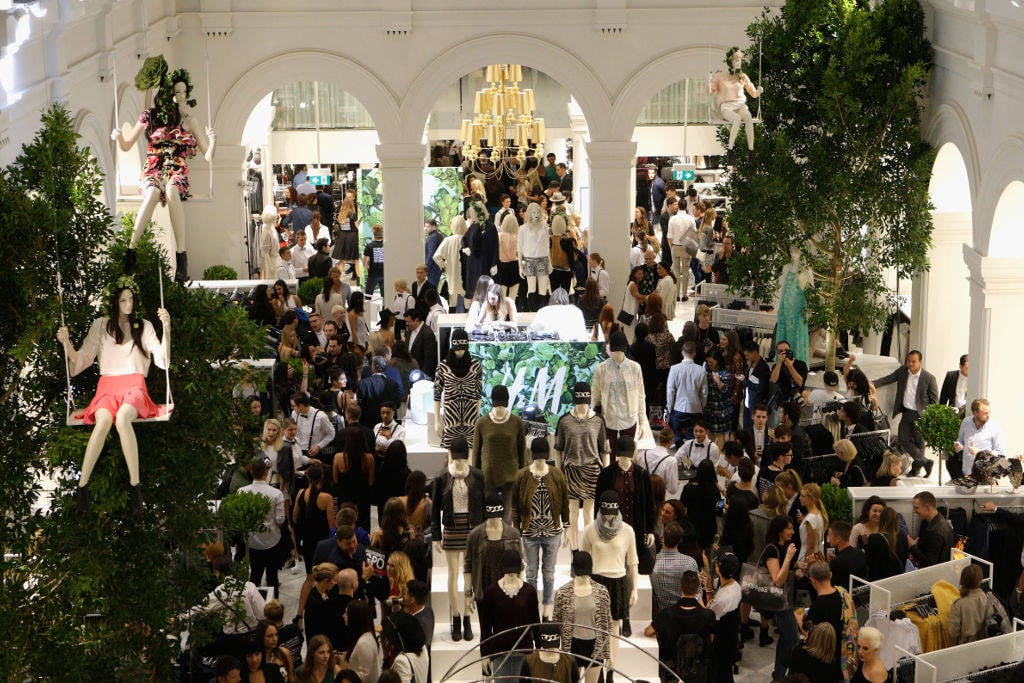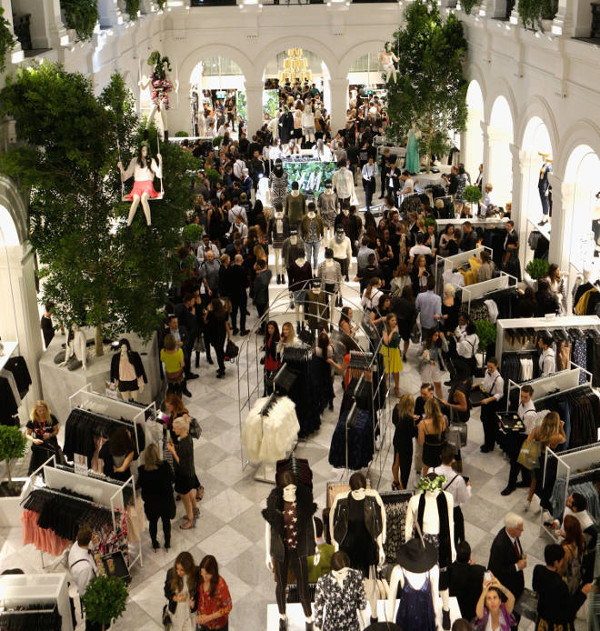Why I’m Not Excited About H&M’s Australian Launch
The Australian media has embraced the Swedish retail giant with open arms, but what's the true cost of those low, low prices?

As H&M opened the doors to its first Australian store in Melbourne over the weekend, fashion media and consumers alike were chomping at the bit for the retailer’s dirt-cheap ‘fast fashion’. Labelled by some as “the best thing to happen in Australia all year”, H&M’s 5000-square metre, three-level megastore in Melbourne’s GPO building houses over one million items of fashion, accessories and homewares, and all at prices so cheap that you needn’t think twice before buying.
And therein lies the problem. Well, one of the problems. H&M, with their $6.95 tanks and $12.95 jeans, encourage the kind of mindless consumerism that fast fashion thrives off — buy cheap and buy lots. The proliferation of wallet-friendly clothes and accessories that are ‘designer-inspired’ (a lovely little euphemism for ‘shameless rip-off’) has led many to confuse this increasing disposability of fashion with ‘democratisation’.
But with cheap prices, the victor isn’t really the consumer — it’s the fast fashion empires. Quantity over quality is a horribly unsustainable approach, but it’s the reason why H&M Chairman Stefan Persson is making mad bank (est. $32.8 billion), and also why most of our fast fashion purchases literally fall apart at the seams before even coming close to the 30th wear (the number recommended by sustainability journalist, Lucy Siegle).
Fast Fashion’s Hidden Costs
Fast fashion’s seductively low prices encourage us to buy things we don’t need (and sometimes don’t really want) with little regard for the enormous environmental and human costs of this rapid-fire supply chain that squeezes margin from those who are most vulnerable — garment workers in developing nations halfway across the world. H&M are estimated to produce 20-25% of their products in Bangladesh, making them the largest player in the country, and while they have gone some way to working towards a living wage (they aim to pay their workers a living wage by 2018), Labour Behind The Label — a UK-based collective of trade unions, charities and consumer organisations who work to support workers’ rights — argues that H&M’s projects “do not show evidence of delivering a living wage for workers any time soon” and that they have yet to put a figure on what the living wage actually is. H&M don’t own any of their own factories, and while they require their direct suppliers to sign a Code of Conduct and are subject to their Full Audit Program, they acknowledge that they don’t have direct contact with or influence over “second-tier” suppliers. It’s this lack of transparency in supply chains that leads to exploitation of workers, and in extreme cases, tragedies like Rana Plaza last April.
To be fair, though, as far as fast fashion empires go, H&M is not all evil. In fact, it was recently named as one of the ‘World’s Most Ethical Companies’ according to Ethisphere for its leadership in signing the Bangladeshi Accord on Fire and Building Safety, as well as its ‘Conscious Exclusive’ collection made from sustainable materials. It is also one of the world’s largest buyers of organic cotton. But these achievements are dwarfed by the sheer amount of resources used to make the estimated 550 million garments it sells each year.
Fast fashion is a huge drain on the environment — the textile industry is one of world’s largest users and polluters of water, thanks to the prevalence of cotton (a very thirsty plant grown in mostly dry regions like India, Mali and southern USA), as well as the many chemicals and dyes used in treating fabric. A single pair of jeans uses up to 5678 litres of water, and emits the same amount of carbon dioxide as driving 125km. No matter how many ‘conscious collections’ H&M produce, as long as they make more and more clothes, their impact on the environment is significant. As Siegle wrote in her analysis of H&M’s 2012 sustainability report, “Despite an understanding of all the pressures on Planet Earth sketched out in the report, there are no plans to scale back on ambition or indeed inventory.”
Besides the manufacturing costs of fast fashion, there is also the economic impact to local retailers and designers that will be felt as international fashion empires move in. Of course, healthy competition and a range of options is a great thing for the fashion customer, but Australian boutiques run the risk of being priced out of the market by H&M’s global buying power. Plus, the speed in which H&M can copy catwalk trends will drive sales away from Australian designers, many of whom are already flailing (think Ksubi, Lisa Ho, Kirrily Johnston and Alannah Hill to name a few).
While you may argue that there is no crossover between the H&M and high-end designer customer, the response to last week’s launch by the fashion media suggests otherwise. As I watched my Instagram feed swell with giddy images of the thousand-odd media, bloggers and celebrities that flocked to the Melbourne store for the big event, it was clear that the industry was drinking the H&M Kool Aid.
H&M are a well-oiled marketing machine, and the launch was major: 300 Sydney VIPs were flown down to Melbourne on a special flight, and indie-pop darlings Haim were brought in from Los Angeles to DJ the event. Luxury fashion titles like Vogue Australia, Elle and Harper’s Bazaar covered the event, despite H&M being far from the designer labels they usually endorse. On the eve of Australian Fashion Week, it was H&M — a Swedish fast fashion, mass-market retailer — that dominated the fashion pages, leaving local designers in the dark. Through a spectacular event and a generous media buy (just have a look at the banner ads bordering this Vogue gallery), H&M has managed to spin fashion credibility out of thin air.
As H&M continues to feed our clothing addiction with some of the lowest prices this country has ever seen, the fast fashion machine grows ever more powerful. The race to the bottom speeds up, and all the while the fashion media sips on champers and toasts the arrival of another mass-market giant. Instead of critically examining the company’s effect on the retail and fashion industry, we are left with images of ‘media personalities’ getting drunk on H&M’s bar tab. The publicists won this round — the complete narrative of H&M has been obscured by beautiful people in shiny clothes.
There’s no doubt the retailer, like Topshop and Zara before it, will find massive success in the Australian market — we do love a bargain. But if you find yourself in line this week at the Melbourne store, among the thousands of other shoppers, please take a moment to think about the true cost of your $12.95 skinny jeans.
–
Maddy Newman runs a fashion magazine for a major e-commerce company. Before that she produced a talk-back radio program for the over 65s. Consequently, she knows a lot about the Internet, shoes and Andre Rieu.

